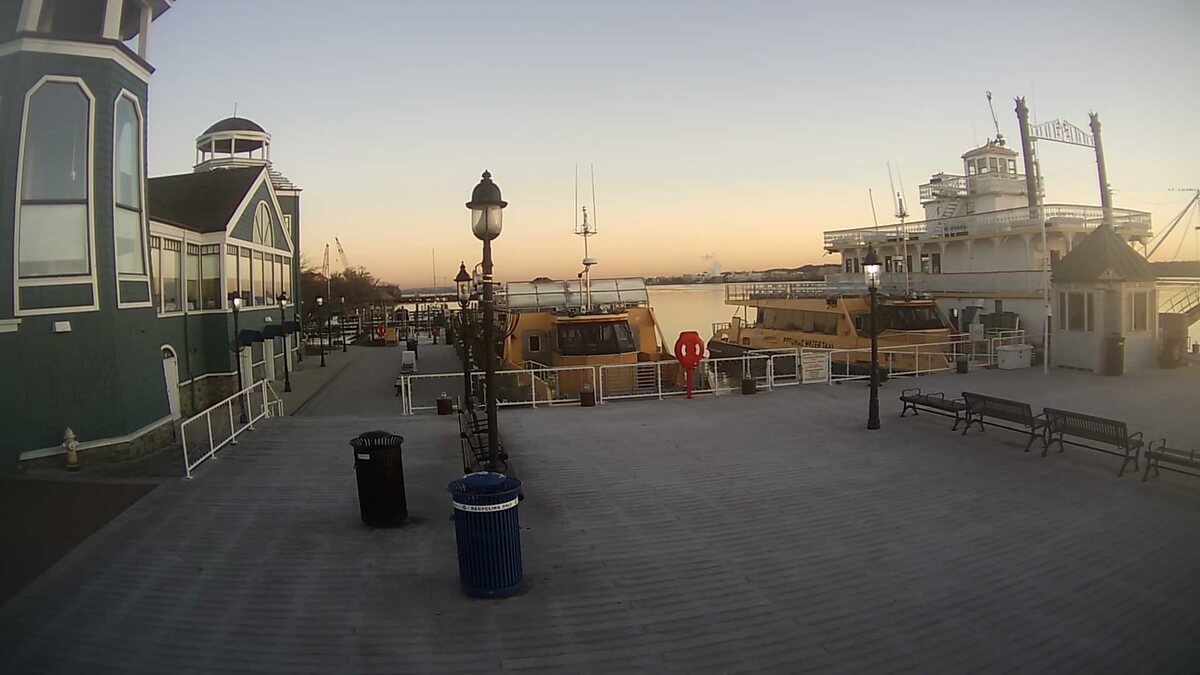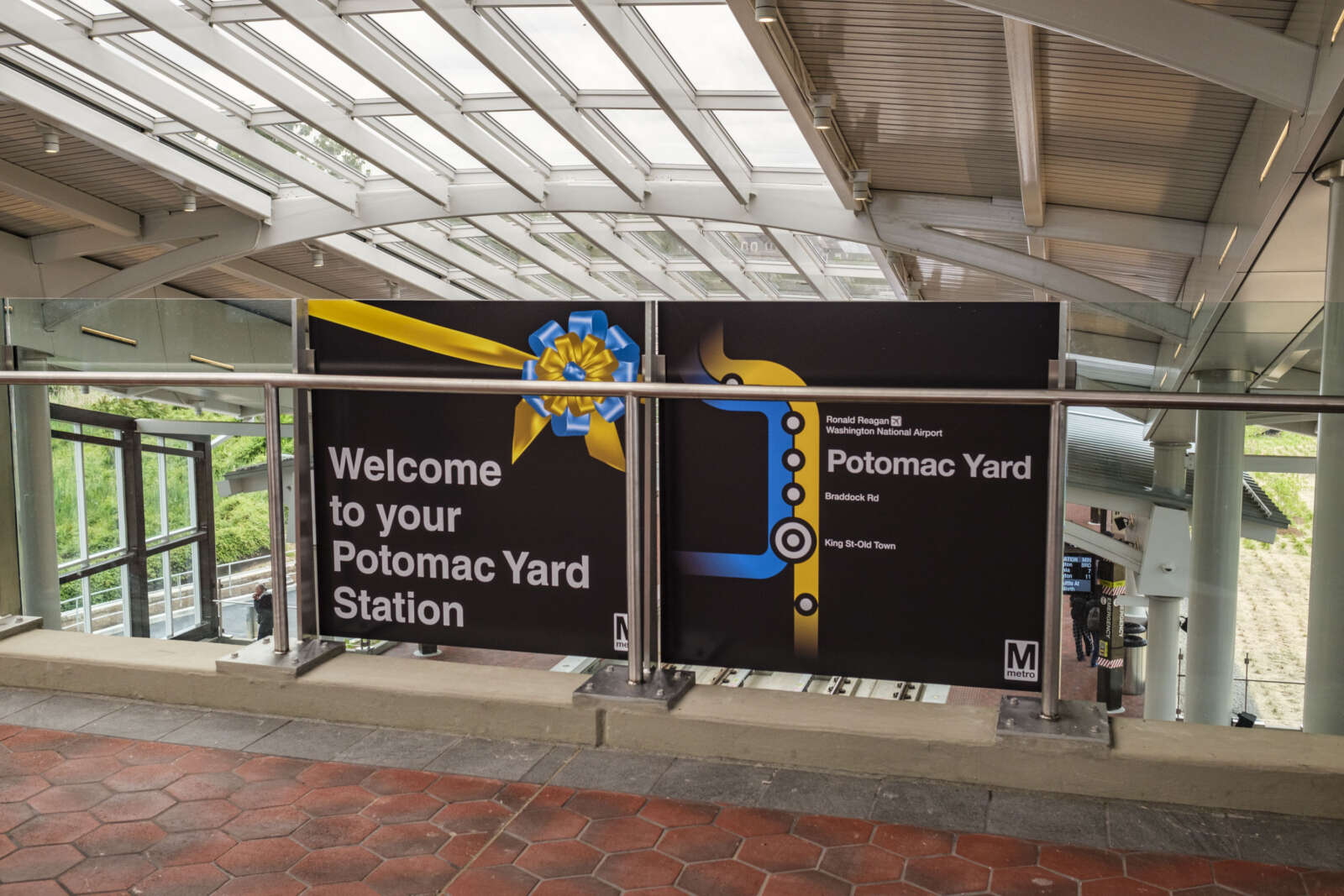
One of the biggest concerns about the Potomac Yard arena has been the transportation plan: how can the city effectively get arena traffic to and from Potomac Yard?
A transportation study by consultant Kimley-Horn outlined both challenges and possible solutions to transportation concerns.
The study said that the current Potomac Yard Metro station has several pinch points that will be over capacity after events at the arena. The study showed that nearly every point on the station, from the platforms to the ticket machines, will be over capacity after events with crowding and excessive queuing.
The study said improvements to the station could cost anywhere between $35 to $70 million, with transit service enhancements costing between $2.5 to $7.5 million annually in additional post-event Metrorail trains, increased bus service and more.
“With investments in transit service, multimodal infrastructure, and technology, the development will achieve desired non-auto mode split of at least 50% within the stated budget,” the report said.
A presentation on the study is available online and mayor Justin Wilson said the City of Alexandria will host a community conversation with Kimley-Horn next week about transportation planning.
Next Thursday evening at 7 PM, we continue engagement on North Potomac Yard, as we will be hosting a community conversation with representatives from the Commonwealth and @KimleyHorn answering your questions on transportation planning:https://t.co/7B936hvOuv
— Justin Wilson (@justindotnet) February 15, 2024
The event is virtual only and will run from 7-8:30 p.m.
Attendees can register online to attend.
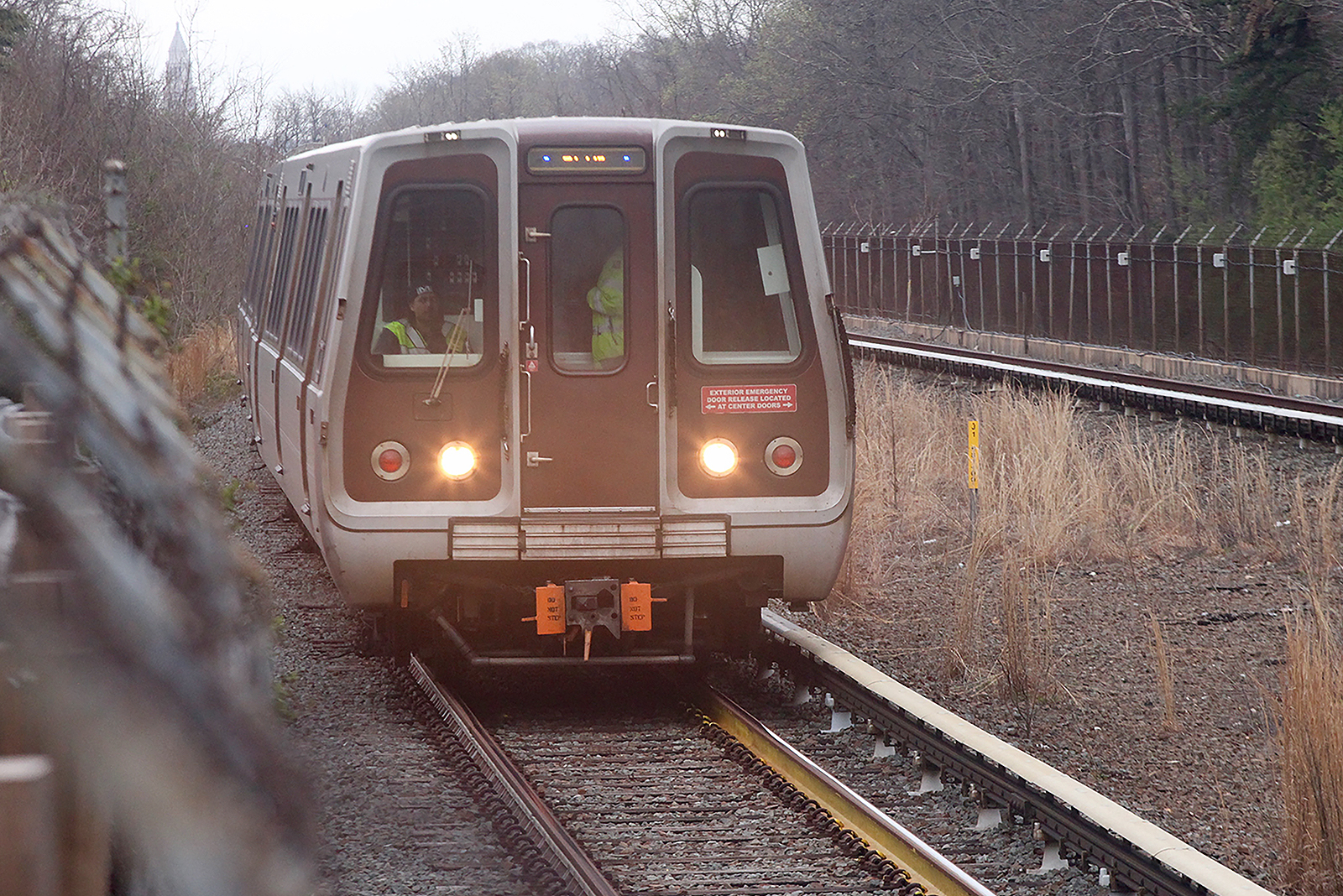
Alexandria was spared Metro construction work this summer, but could see closures and delays on the Blue Line next year.
The Washington Metropolitan Area Transit Authority (WMATA) said in a release that Blue Line construction is expected sometime in summer 2025 from the Franconia-Springfield Metro station to the King Street Metro station.
The Van Dorn Street and Franconia-Springfield Metro stations will be closed, according to WMATA, while the train control system, signal systems, and other systems are upgraded.
The exact date of the closures is still to be determined, but WMATA said it’s likely to last approximately three weeks.
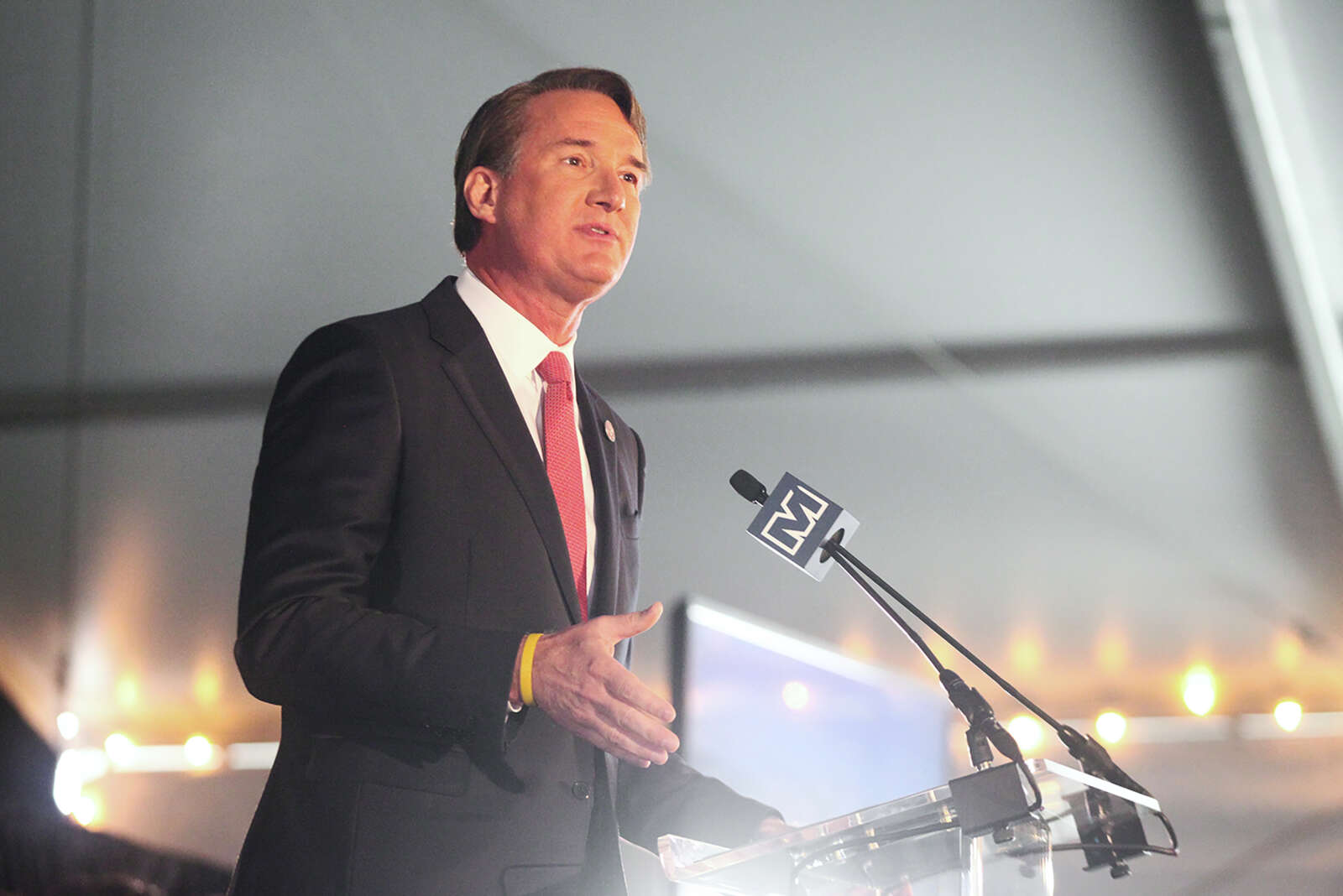
Governor Glenn Youngkin visited the Potomac Yard Metro station yesterday (Thursday) to address plans for the transit system’s future, the Richmond Times-Dispatch reported.
While Youngkin signaled he’s open to some additional support for Metro, Youngkin also pushed back against claims from leaders like State Sen. Adam Ebbin that Metro funding is “a prerequisite” to the Potomac Yard Metro arena.
The Richmond Times-Dispatch said Youngkin claimed that helping Metro close the $750 million operating deficit is ‘disconnected’ from the arena project.
The station has been the epicenter of many arguments about the new Potomac Yard arena planned to host the Washington Capitals and Wizards. Both Alexandria and Metro leaders said the station cannot support arena crowds — with a new report said wait times at the station could run well over an hour if no upgrades are made.
A transportation plan presented last week said a widened bridge, new escalators, and additional fare gates would be added to the station. Those upgrades are estimated to cost between $35 million and $70 million.
With those upgrades, the station could still crowd heavily for 30-45 minutes after events.
Youngkin also said he wants the transit system to do more to crack down on fare evasion, raise fares and reduce labor costs, the Richmond Times-Dispatch reported.

It’s a classic trope, from the epic of Gilgamesh to the Fast & Furious: two enemies or rivals have to team up and put their differences aside to tackle a bigger threat.
Like some of the best odd couple pairs, Republican Gov. Glenn Youngkin and the mostly Democratic City of Alexandria have had some pretty public feuds, but the Potomac Yard arena and connected Washington Metropolitan Area Transit Authority (WMATA) funding could make for strange bedfellows.
In a recent newsletter, Mayor Justin Wilson noted that Youngkin has signaled that he could be an ally in Alexandria’s push for greater Metro funding.
According to the newsletter:
As the General Assembly works to address this challenge, Governor Youngkin has now signaled his support for increased state funding for WMATA in conjunction with approval for the North Potomac Yard Entertainment District proposal.
Addressing this financial gap will require collective action across the three state governments, its local jurisdictions (including Alexandria) and the Federal Government. This type of conversation is one that is playing out around the nation, but it will require a series of difficult decisions locally.
Youngkin had previously opposed expanding Virginia’s role in funding WMATA and, earlier this month, said he expects funding to come with the expectation of reforms within Metro leadership — namely driving down costs and improving fare collection.
@GovernorVA says (i'm paraphrasing) he's encouraged by conversations he's having w/legislators and "There is a mutual commitment to collaborate together on a solution to WMATA’s short-term funding needs as part of this discussion to deliver a world-class transportation system." https://t.co/DqdfMKQcup
— Jahd Khalil (@jahdkhalil) January 19, 2024
Metro funding has been a crucial piece of the Potomac Yard arena discussions, with both Wilson and Metro GM Randy Clarke saying the current Potomac Yard Metro station can’t handle the traffic at the proposed arena. Beyond just that infrastructure limitation, the brand new Potomac Yard Metro station was on the chopping block when WMATA was reviewing stations to close due to budget cuts.
State Sen. Adam Ebbin described increased funding to Metro as a ‘prerequisite‘ to any discussion of the new Potomac Yard arena.
Even as city leaders say the new project will be reliant on the Metro for transportation, WMATA faces a possible death spiral with a $750 million shortfall.
“With the presentation of a sobering budget, the WMATA staff presented a dire picture of the region’s transit finance in the future,” Wilson wrote. “A combination of relief that had been provided to the taxpayers of local jurisdictions during the pandemic, decreased fare revenue and the impact of inflation and collective bargaining agreements for WMATA’s employees has left a $750 million operating deficit going forward.”
Wilson said the shortfall can’t be addressed with fare increases and service reductions alone, given that both might drive ridership even lower.
While Metro hit a post-pandemic ridership peak at 563,000 riders in November, Wilson noted that’s still less than the average ridership of 626,000 pre-pandemic and Metro’s average ridership is still only half what it was pre-pandemic.
Wilson also noted that nearby localities can’t shoulder the tax burden to compensate for the decline in ridership. Alexandria currently contributes $56.6 million to WMATA’s operating budget and $16.6 million in capital contributions, Wilson wrote.
According to the newsletter:
Addressing this financial gap will require collective action across the three state governments, its local jurisdictions (including Alexandria) and the Federal Government. This type of conversation is one that is playing out around the nation, but it will require a series of difficult decisions locally.
Transit is essential to our region’s economy and our quality of life, but the financial model that has supported its existence for a generation is upside down. The work ahead requires defining a new model to sustain transit for another generation.
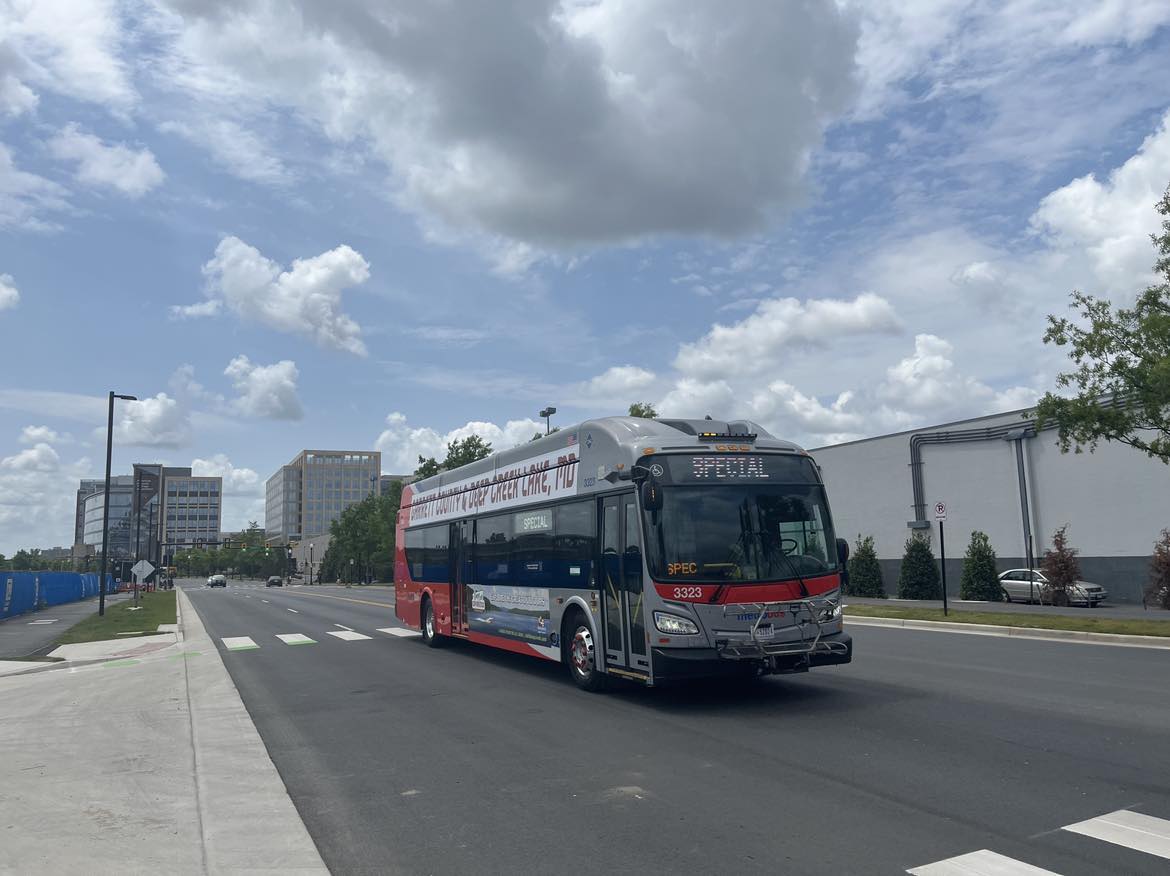
If Metrobus service is cut back, as WMATA has threatened, several Alexandria lines could be on the chopping block.
General Manager Randy Clarke warned that bus service cuts and job cuts are imminent if the transit agency doesn’t close its $750 million budget gap, adding that he said it’s time for a regional tax to permanently fund WMATA.
Under the drastic cuts proposed by Clarke, all stations would close at 10 p.m., train frequency would drop, and ten stations would be shut down. Among the stations being considered for a shutdown is Alexandria’s new Potomac Yard station, which is also the centerpiece of transit plans for the new Monumental arena.
Clarke also released a list of bus routes, nearly half the Metrobus lines, that would be cut or have reduced service. Many of those routes in Alexandria go through the West End to connect to the Pentagon
The Metrobus lines in Alexandria that would be cut include:
- Route 8W runs through the West End to the Pentagon
- Routes 17B, 17G, 17K and 17M, also running through West End to the Pentagon
- Routes 18G, 18J, 18P, which go through Springfield, up into Alexandria’s West End, and finish at the Pentagon
- Route 21C from Landmark to the Pentagon
- Route 22A through Parkfairfax and the Bradlee Shopping Center up to the Pentagon
- Route 22F from Northern Virginia Community College up to the Pentagon
- Route 28F from S. George Mason Drive up to the Pentagon
- Route 29G from Annandale, through the West End, up to the Pentagon
- Route MW1 from the Braddock Road Metro station to Pentagon City
- Route NH2 from the King Street Metro station to National Harbor
Other routes in Alexandria could see reduced service, including:
- Route 7A from the Van Dorn Metro station up to the Pentagon Metro station
- Route 28A from the King Street Metro station to Tysons
- Route 29K from the King Street Metro station to George Mason University
- Route 29N from the King Street Metro station to the City of Fairfax
State Sen. Adam Ebbin previously said that Metro funding is a ‘prerequisite‘ for Potomac Yard plans and Gov. Glenn Youngkin’s budget proposal includes the possibility for Metro to receive increased local funding.
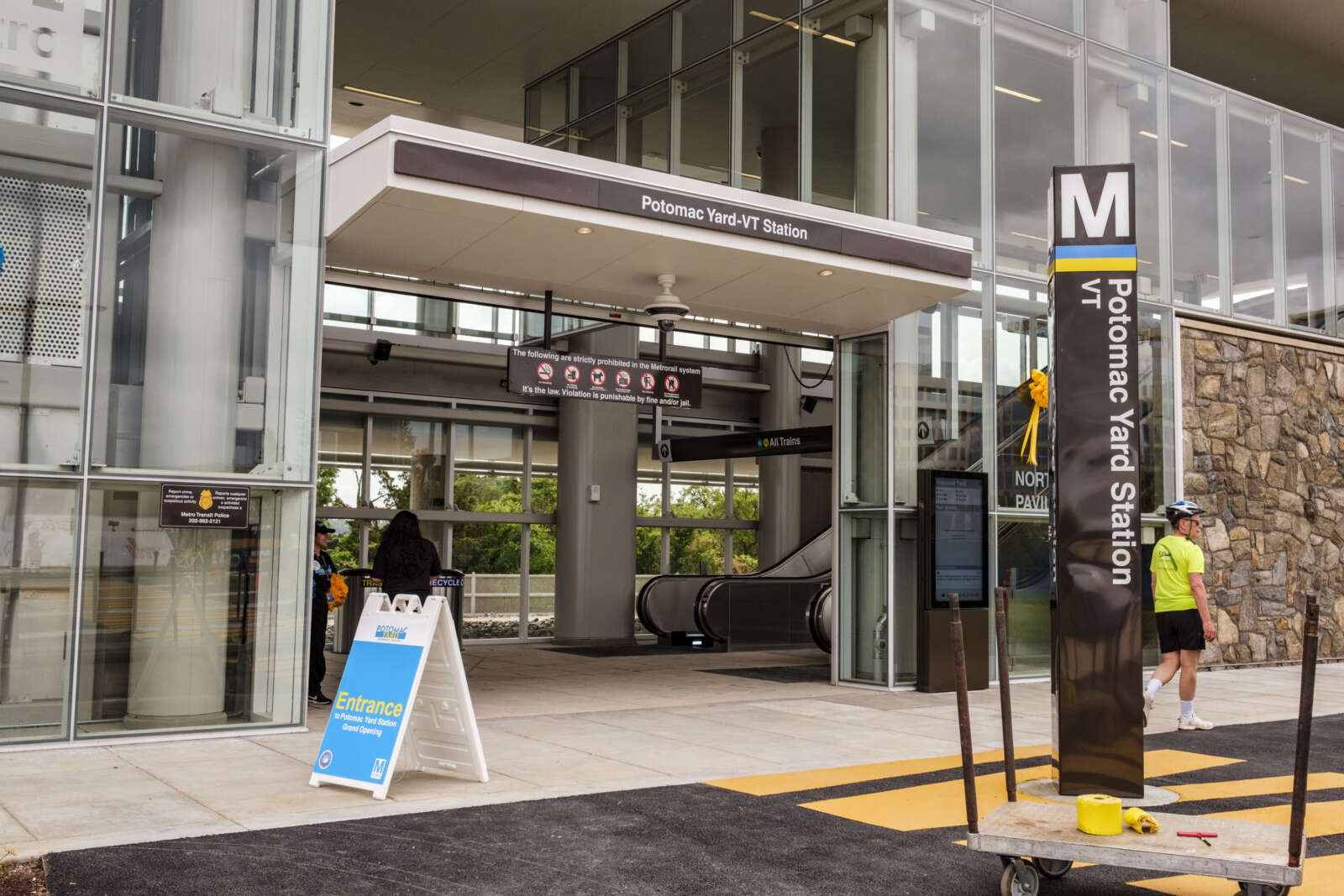
With WMATA announcing potentially drastic cuts to the Metro system, some Alexandria leaders are saying the Potomac Yard arena announcement can be leveraged to get Virginia to pony up more support.
In case you’ve been living under a rock, last week Virginia Gov. Glenn Youngkin took to the stage with local leaders and Washington Capitals and Wizards owner Ted Leonsis to announce plans to build a new arena in Potomac Yard.
State Sen. Adam Ebbin said on Twitter that the Potomac Yard plans are contingent on funding the Metro, which previously said the Potomac Yard Metro station was on the chopping block if WMATA can’t close it’s $750 million budget gap.
“Metro money is a PREREQUISITE for ANY serious consideration of the governor’s proposal,” Ebbin wrote.
Jim, Metro money is a PREREQUISITE for ANY serious consideration of the governor's proposal. Whether or not this deal moves ahead we must have Metro running to allow NoVA's economy, and the Commonwealth's economy, to continue running!
— Adam Ebbin 🇺🇦 (@AdamEbbin) December 18, 2023
Mayor Justin Wilson and City Council member Kirk McPike noted at the meeting that the Potomac Yard Metro station is integral to Potomac Yard plans, especially with the city pushing to minimize the amount of parking at the site.
At the same time, however, Wilson acknowledged that the Metro station is currently inadequate to handle arena traffic.
“There’s no way the current station can accommodate this use as is,” Wilson said. “A significant chunk of transportation investments will require improvements to the station.”
Wilson said the Metro station, which opened earlier this year, will need upgrades. Metro GM Randy Clarke confirmed that not only is the Potomac Yard station not up to handling arena traffic, but said no one contacted Metro before the Potomac Yard announcement.
As big a deal as was made about the Potomac Yard Metro being a huge reason the Wizards/Capitals want to move to Virginia, apparently no one actually contacted Metro before yesterday's announcement. GM Randy Clarke said today no one called him… (1/2) #wmata pic.twitter.com/X2tGVNWNAg
— Tom Roussey (@tomroussey7news) December 14, 2023
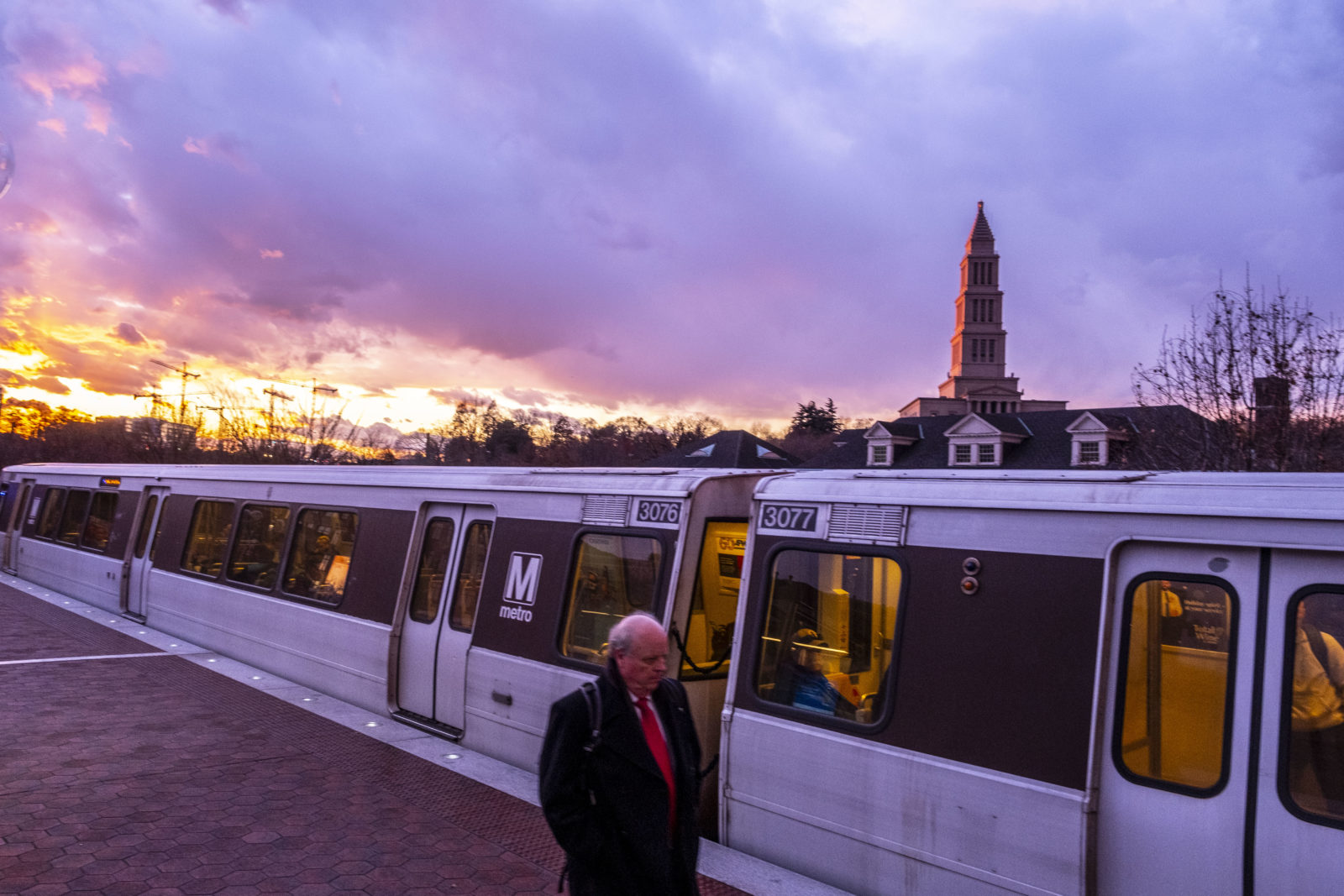
WMATA is having a pretty tough week, with bus lines on the chopping block and ten stations facing possible closure — including, awkwardly, the new Potomac Yard Metro station that’s a central part of plans for a new arena.
To make matters worse, it comes on the 40th birthday of three Alexandria Yellow Line stations.
The Office of Historic Alexandria noted in its weekly newsletter that this weekend marks 40 years since the Braddock Road, King Street and Eisenhower Avenue Metro stations opened on the Yellow Line.
According to the newsletter:
On December 17, 1983, the Braddock Road, King Street, and Eisenhower Avenue Metro stations opened on the Yellow Line. Passengers traveling from the new stations received free one-way trips for part of the day. At the King Street station, opening festivities included bagpipe music and ribbon cutting by Senators Chuck Robb and John Warner.
Service on the rest of the Yellow Line started in April of 1983, but the Alexandria stations came a little later.
The Yellow Line has seen some tough times in recent years, with a closure south of National Airport in 2018 and some closures, notably of the Eisenhower Avenue station, during Covid, but Metro remains by far the most used public transit in the region.
Good Friday morning, Alexandria!
☀️ Today’s weather: Expect sunshine and a high temperature near 56 during the day, accompanied by a west wind blowing at 6 to 9 mph. The night will be mostly clear with the temperature dropping to around 34, and a west wind at a slightly lower speed of 3 to 5 mph.
🚨 You need to know
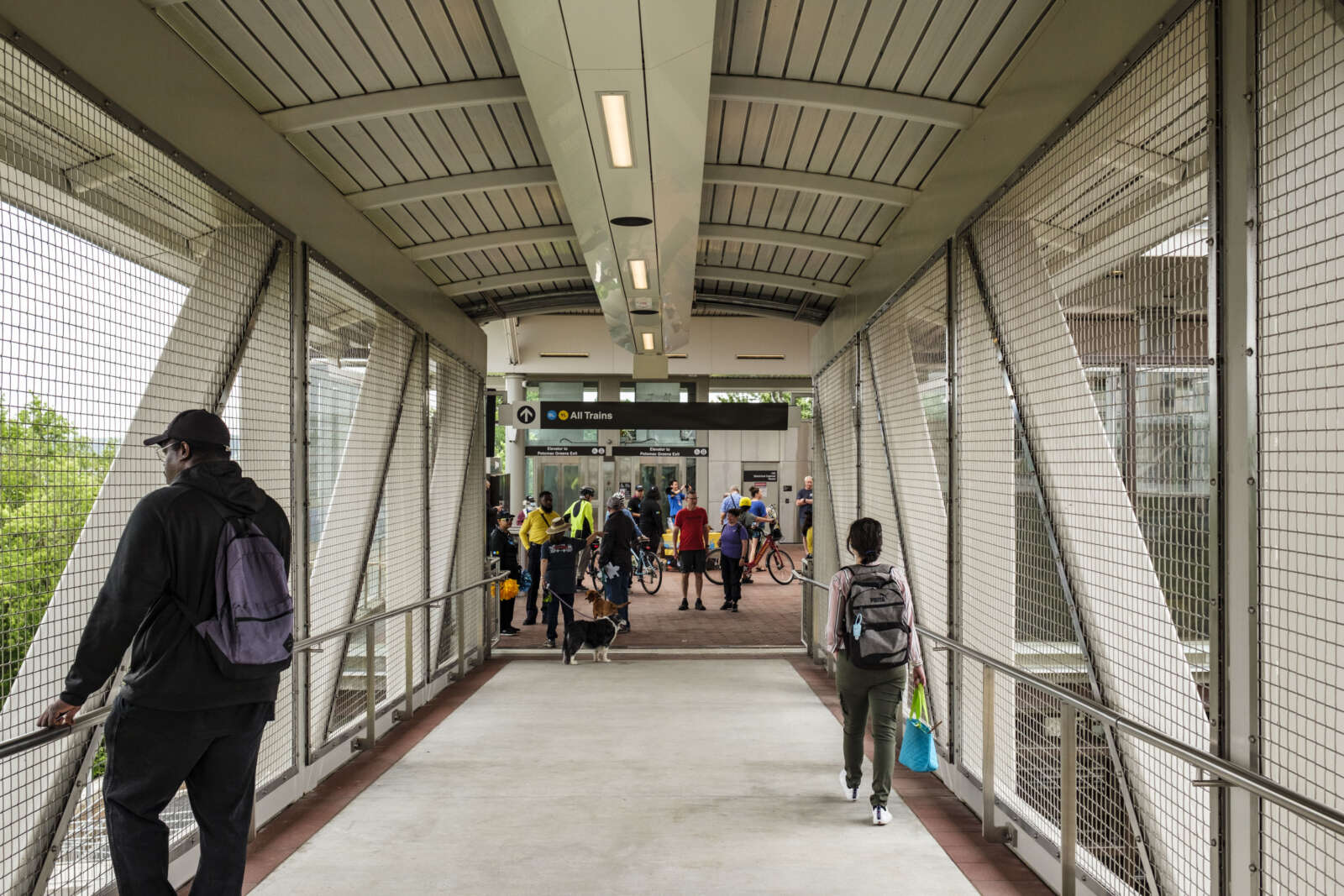
While Mayor Justin Wilson said WMATA was aware of the Potomac Yard arena discussion, ABC7 reported that Metro GM Randy Clarke said no one called him before the announcement.
Like Wilson, Clarke acknowledged that the current station is wholly inadequate to handle the kind of crowds expected for a Potomac Yard arena with the Washington Capitals and the Washington Wizards. The current station has only one escalator and staircase on each platform.
“There’s no way the current station can accommodate this use as is,” Wilson told the Del Ray Citizens Association. “A significant chunk of transportation investments will require improvements to the station.”
Whether the station even remains open is currently open for discussion, as Potomac Yard is currently on a list of ten stations that could close if Metro is unable to close its $750 million budget gap.
📈 Thursday’s most read
The following are the most-read ALXnow articles for Dec 14, 2023.
- Alexandria Mayor: Potomac Yard arena will have minimal parking, but Metro station currently inadequate (12440 views)
- Northern Virginia Association of Realtors says Amy Jackson’s mayoral endorsement never happened (2060 views)
- Decades-long theater collaboration at Alexandria City High School coming to an end (1220 views)
🗞 Other local coverage
- Fentanyl Gummy Bears | School Bathroom Swastika | NoVA Arena: VA News
Patch (Thursday @ 5:12 pm)
- Restaurants Open Christmas Eve, Day 2023 In Old Town Alexandria
Patch (Thursday @ 3:17 pm)
- Arena’s “Swept Away” is a Dark Tale on the High Seas with Music by Grammy Winners The Avett Brothers
Zebra (Thursday @ 11:58 am)
- Patch Survey: Do You Support Capitals, Wizards Arena In Alexandria
Patch (Thursday @ 10:07 am)
- A Monumental announcement
Alexandria Times (Thursday @ 9:57 am)
- Filling in the Blanks with Melanie Kay-Wyatt: Redefining the high school experience
Alexandria Times (Thursday @ 9:51 am)
- City’s biodiversity faces uncertain future
Alexandria Times (Thursday @ 9:48 am)
- Ireton boys’ hoops squad bests ACHS
Alexandria Times (Thursday @ 9:45 am)
- Holiday Gift Guide: Giving the gift of activity
Alexandria Times (Thursday @ 9:32 am)
- Sheriff’s Dept. Seeks Donations for Operation Elf
Alexandria Living (Thursday @ 7:46 am)
- Romano’s Macaroni Grill May Close in Kingstowne
Alexandria Living (Thursday @ 7:27 am)
📅 Upcoming events
Here is what’s going on today and this weekend in Alexandria, from our event calendar.
- 6:00 pm Friday: Alexandria Holiday Lights Ride + Walk
- 10:00 am Saturday: Holiday Storytime
- 6:00 pm Saturday: Alexandria Holiday Lights Ride + Walk
- 7:30 pm Saturday: Celebrate the season – Holiday with a twist
- 8:00 pm Saturday: Alexandria VA Karaoke at Hops N Shine

(Updated 9:55 p.m.) Bailing Metro out of its $750 million budget shortfall is going to sting the budgets of localities next year, and the Metropolitan Washington Council of Governments (COG) expects to release a plan addressing it next month.
COG Director Clark Mercer said that the organization’s Chief Administrative Officers (CAO) Committee work group on Metro’s cost structure will release a report next month outlining three options for Metro to consider. One of those options includes a one-time option to use Metro’s preventative maintenance fund against the balance for the next year or two, potentially cutting the shortfall by hundreds of millions of dollars.
“Most transit systems in the country do this on a regular basis,” Mercer told ALXnow. “But what Metro has heard kind of loud and clear is that the region cannot absorb a $750 million bill on top of what they already paid this year. What are some other options? It’s a big, huge mountain to climb.”
Mercer said that Metro CEO Randy Clarke has identified $50 million in ongoing savings from eliminating consultants, as well as nearly $100 million from this year’s budget that will roll over into next year’s budget.
“Just so you know, that fiscal cliff of $750 million, once moving those preventative maintenance dollars up, the next year that cliff is still there,” Mercer said. “It goes down to $300 or $400 million, then up to $750 million again. Those numbers are real.”

COG acts as a regional powerhouse, corralling 24 member jurisdictions (with about six million residents) to get on the same page on regional initiatives like transportation planning, affordable housing, law enforcement and environmental sustainability. Last month, COG released a statement in response to the Washington Metropolitan Area Transit Authority’s financial update.
“Our region’s economy and quality of life depend on a reliable, sustainable Metro system,” stated COG Board of Directors Chair Kate Stewart, who is a Montgomery County Councilmember. “State, local, and federal leaders need to prioritize ensuring we avert the fiscal cliff facing the system and work together to find a long-term, sustainable funding solution.”
The CAO work group, which compiled the report and recommendations, is chaired by Alexandria City Manager Jim Parajon.
COG is made up of about 130 employees, and nearly half of them work in transit with the Transportation Planning Board for the region. Additionally, Metro’s budget has to be approved in the organization’s long-term plan to get federal funding.
Mercer said that not funding Metro by next summer would result in a “transit death spiral.”
“You’re not gonna be able to recruit a company to this region without a well-run Metro system,” he said. “One reason Amazon came where they came was because of Metro, and there are a lot of companies like that.”
Mercer continued, “We can say, ‘We don’t want to fund it, and we want a poorly run Metro,’ and that’s a disaster for the region,” Mercer said. “Option one is a transit death spiral.”
In 2018, jurisdictions in the region agreed to cap their funding to Metro to $500 million, and to increase their allocation no more than 3% every year. Now with Metro’s $750 million shortfall, that 3% needs to be re-baselined with Virginia and Maryland state legislators, Mercer said.
“The second option is to look at the way that Metro is funded — from Richmond, Annapolis, the District of Columbia, and the federal government,” Mercer said. “Ask any business person if they want their budget approved every year by four different boards of directors. Funding options needs to be discussed over the next year.”
Without a funding increase from Alexandria and its neighbors, WMATA reported “unprecedented operating deficits” will force it to make drastic cuts to rail, bus, and paratransit services across the region.
Like trains pulling into a station, regional transportation leaders converged in Alexandria today to cut the ribbon at the Washington Metropolitan Area Transit Authority’s new technology hub, the Metro Integrated Command and Communications Center (MICC).
The new 14-story MICC, located at 2401 Mill Road in the city’s Carlyle neighborhood, will hold up to 1,400 Metro staffers, and is home to the system’s data center, cybersecurity operations, bus and rail video teams, communications, and administrative support.
Metro General Manager and CEO Randy Clarke said the new facility is a game-changer.
“The MICC is a world-class control center that brings our rail, bus, security, and maintenance operations together in one place for the first time and our customer communications teams,” Clarke said. “Instead of managing service from separate control centers, we can coordinate together in real-time, working as a unified team to provide customers with clear, consistent messaging.”
Mayor Justin Wilson said important regional work will be done in the building.
“Metro is a key partner throughout the region, and we are proud they will call Alexandria home,” said Wilson. “The hundreds of employees who will be here will find the Eisenhower Corridor is a great area where they can work, live, and play.”
The MICC is Metro’s final piece of its Office Consolidation Plan, replacing the aging Jackson Graham Building in Washington, D.C.
Metro Board Chair Paul Smedberg, a former Alexandria City Council member, said the move will save Metro millions over the next two decades.
“Metro’s new Alexandria office with the MICC is the last major step in a broader office consolidation strategy that will save the transit authority $120 million over the next 20 years,” Smedberg said. “The Board recognized the importance of implementing this strategy, the goals of which were not only to create a long-term revenue stream, but also to improve employee safety, productivity, and satisfaction.”
Future cost-savings will be crucial, as the region has to help bail the transit system out of a $750 million budget deficit by next summer.


